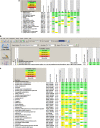Laser microdissection and mass spectrometry-based proteomics aids the diagnosis and typing of renal amyloidosis
- PMID: 22495291
- PMCID: PMC3388518
- DOI: 10.1038/ki.2012.108
Laser microdissection and mass spectrometry-based proteomics aids the diagnosis and typing of renal amyloidosis
Abstract
Accurate diagnosis and typing of renal amyloidosis is critical for prognosis, genetic counseling, and treatment. Laser microdissection and mass spectrometry are emerging techniques for the analysis and diagnosis of many renal diseases. Here we present the results of laser microdissection and mass spectrometry performed on 127 cases of renal amyloidosis during 2008-2010. We found the following proteins in the amyloid deposits: immunoglobulin light and heavy chains, secondary reactive serum amyloid A protein, leukocyte cell-derived chemotaxin-2, fibrinogen-α chain, transthyretin, apolipoprotein A-I and A-IV, gelsolin, and β-2 microglobulin. Thus, laser microdissection of affected areas within the kidney followed by mass spectrometry provides a direct test of the composition of the deposit and forms a useful ancillary technique for the accurate diagnosis and typing of renal amyloidosis in a single procedure.
Figures




References
-
- Dember LM. Amyloidosis-associated kidney disease. J Am Soc Nephrol. 2006;17:3458–3471. - PubMed
-
- Merlini G, Bellotti V. Molecular mechanisms of amyloidosis. N Engl J Med. 2003;349:583–596. - PubMed
-
- Lachmann HJ, Booth DR, Booth SE, et al. Misdiagnosis of hereditary amyloidosis as AL (primary) amyloidosis. N Engl J Med. 2002;346:1786–1791. - PubMed
MeSH terms
Substances
LinkOut - more resources
Full Text Sources
Other Literature Sources
Medical
Research Materials

